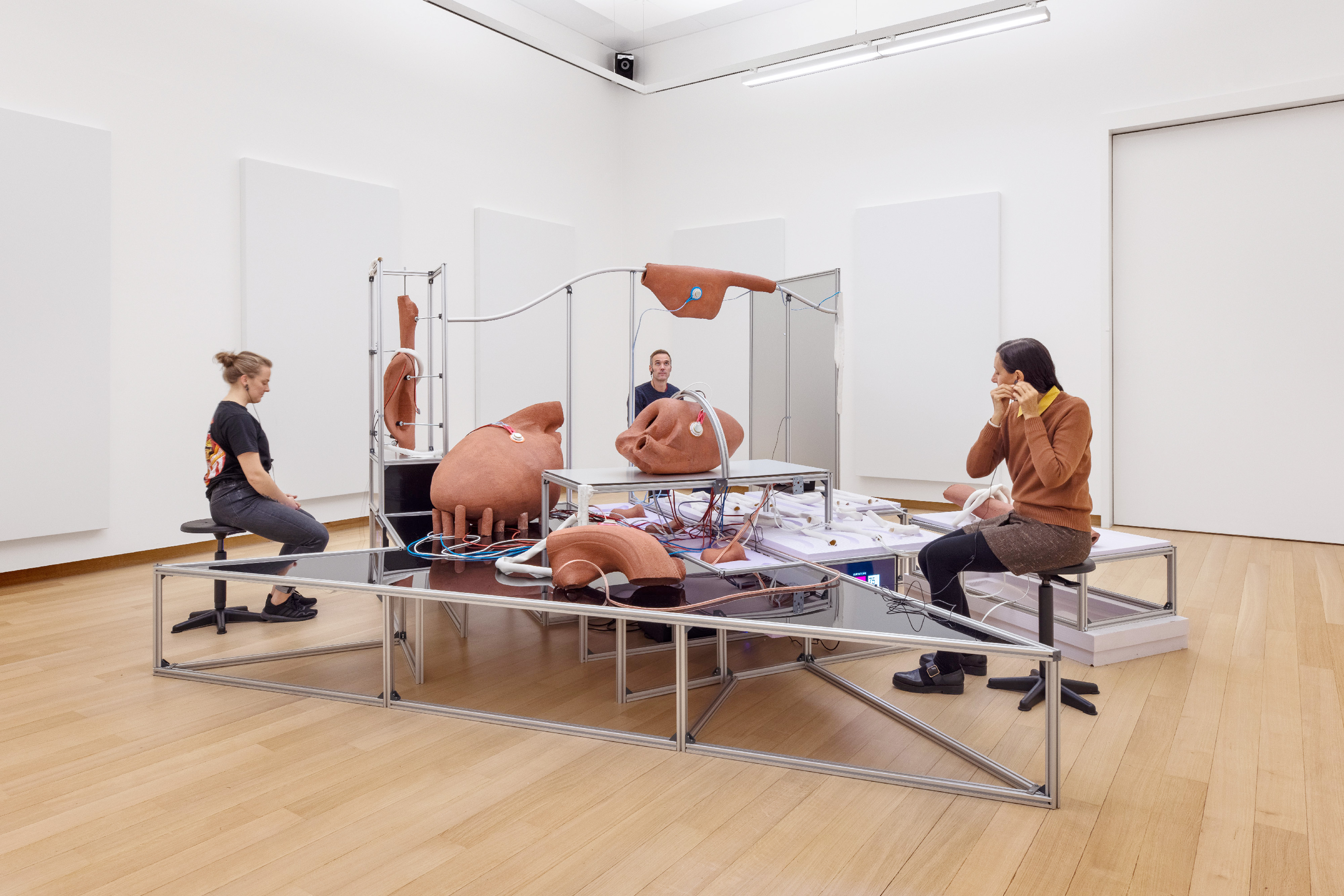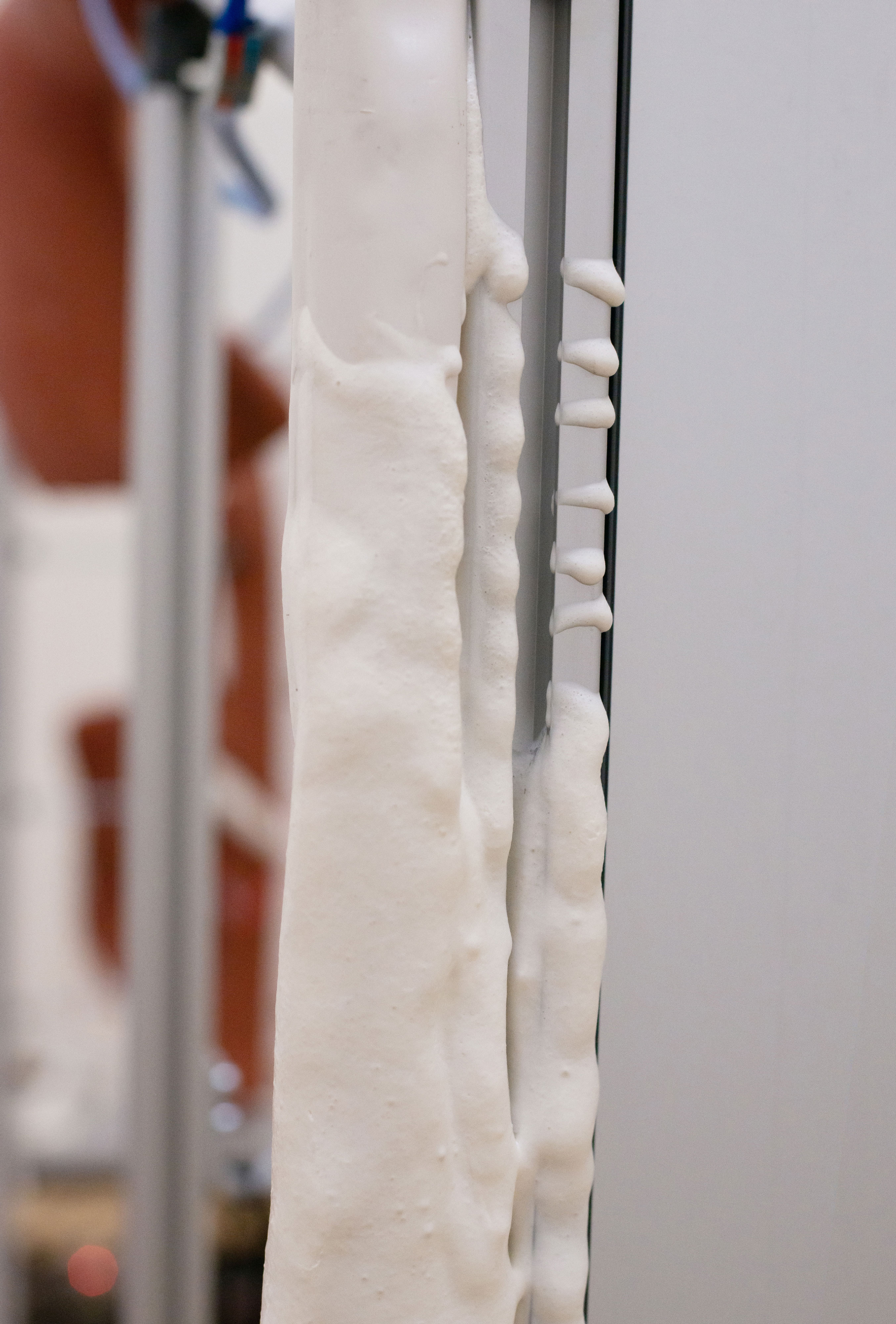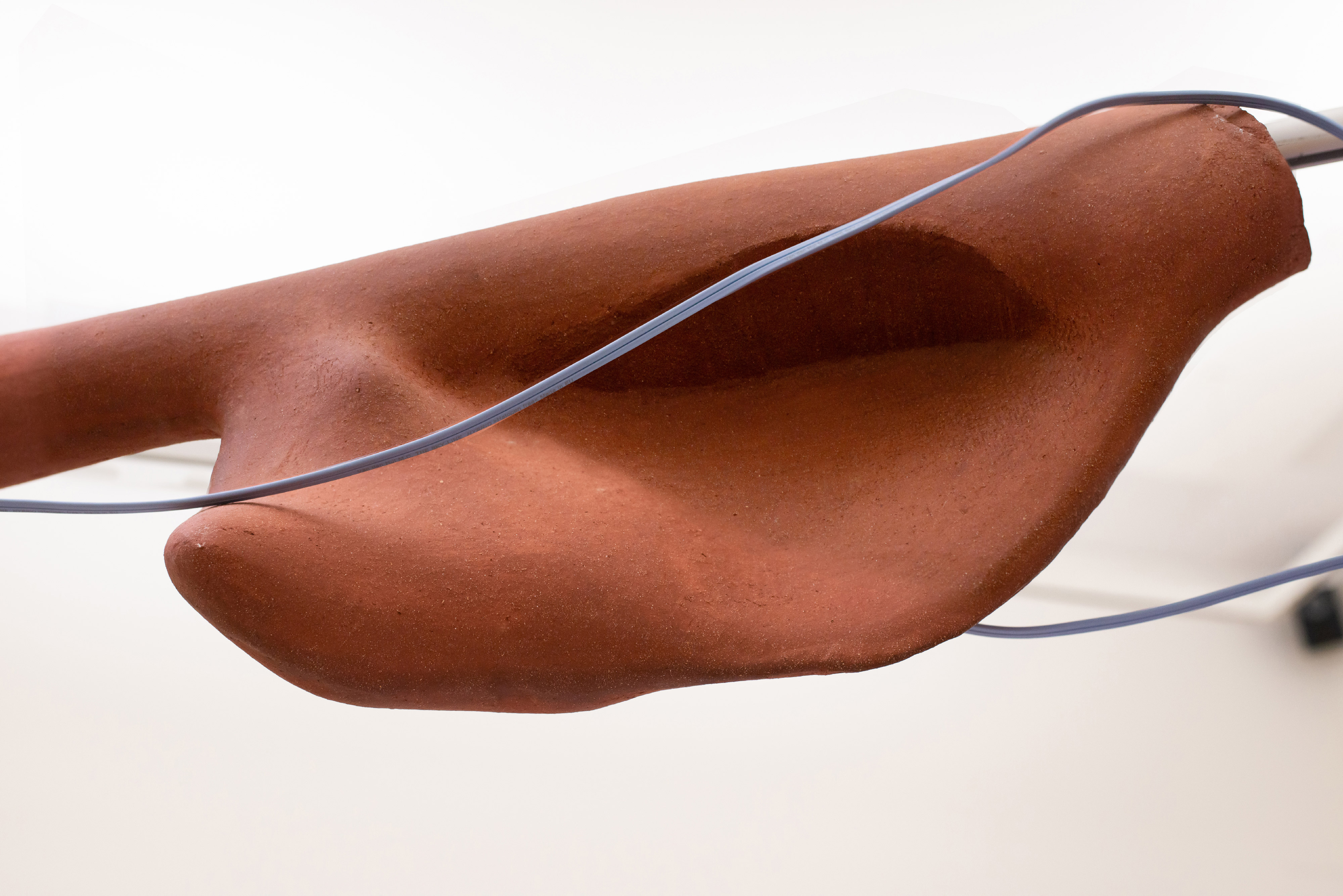Interpersonal Biofeedback Apparatus Encoding Cardiac Fluctuations
2021 (Nomination Prix de Rome)
 Installation shot Stedelijk Museum Amsterdam, Photo: Daniel Nicolas
Installation shot Stedelijk Museum Amsterdam, Photo: Daniel NicolasThis interactive installation examines our urge to exert control over our body, the uncontrollable nature of the conditions that influence how we feel, and the data systems that analyze our state of wellbeing. Visitors are invited to take a seat and place a sensor on their earlobe. Their heart rate variability (HRV), the period between heartbeats, will immediately become audible as the sound of ticking metal friction on ceramics, and squeaking polysterene. Changes in HRV directly impact on the sound composition by Sjoerd Leijten and vice versa.
The sensors register all the irregularities of the heartbeat, which fluctuates in response to physical and emotional factors. Because of the complexities involved in identifying the cause of individual fluctuations, science often dismisses small variations as irrelevant, and only average readings are used for examinations. Coralie Vogelaar explores the “noise” that is ususally filtered out in this hybrid cross of technological research and fine art - the installation exudes the atmosphere of a test environment, with its aluminium tubing, visible cables, and the inbuilt and pre-programmed conditional rules.
Vogelaar demonstrates that our mood states are more complex than would be suggested by an averaged out measurement. She embraces this complexity by combining data-sampling systems with the physical experience of sound, rather than imposing any scientific framework or delimitation.
Interactive 10-channel audio installation: ceramic, aluminium, vibration speakers, sensors, foam panel, acoustic panels, acrylate, SuperCollider algorithmic composition software, MaxMSP design environment for music, video and audio.
Interactive music composition: Sjoerd Leijten
Interaction sensors: Kees Reedijk
Ceramics: Europees Keramisch Werkcentrum (EKWC)
Research: TU/e Innovation Space, Louis Bonnaire
Rolling aluminium: Paul van Dongen, Bestbend
Assistence: Éloïse Alliguié, Elżbieta Szota
video and audio documentation: Jasper de Bruin and Sjoerd Leijten
photography: Daniel Nicolas
Advice: Antonis Pittas, Marjolein Vogels, Marloeke van der Vlugt, Wikke van Houwelingen, Marloes van der Hoek , Annika Kappner, Hendrik-Jan Grievink, Eva Villanueva, Yuri Veerman, Esmee Geerken, Minke Kampman, Wes Broersen
Visitors video documentation: Annika Kappner, Martijn Smid, Ida Kleiterp
Financial support: Mondriaan Fonds, Amsterdams Fonds voor de Kunst (AFK), Niemeijer Fonds, Stedelijk Museum Amsterdam
The sensors register all the irregularities of the heartbeat, which fluctuates in response to physical and emotional factors. Because of the complexities involved in identifying the cause of individual fluctuations, science often dismisses small variations as irrelevant, and only average readings are used for examinations. Coralie Vogelaar explores the “noise” that is ususally filtered out in this hybrid cross of technological research and fine art - the installation exudes the atmosphere of a test environment, with its aluminium tubing, visible cables, and the inbuilt and pre-programmed conditional rules.
Vogelaar demonstrates that our mood states are more complex than would be suggested by an averaged out measurement. She embraces this complexity by combining data-sampling systems with the physical experience of sound, rather than imposing any scientific framework or delimitation.
Interactive 10-channel audio installation: ceramic, aluminium, vibration speakers, sensors, foam panel, acoustic panels, acrylate, SuperCollider algorithmic composition software, MaxMSP design environment for music, video and audio.
Interactive music composition: Sjoerd Leijten
Interaction sensors: Kees Reedijk
Ceramics: Europees Keramisch Werkcentrum (EKWC)
Research: TU/e Innovation Space, Louis Bonnaire
Rolling aluminium: Paul van Dongen, Bestbend
Assistence: Éloïse Alliguié, Elżbieta Szota
video and audio documentation: Jasper de Bruin and Sjoerd Leijten
photography: Daniel Nicolas
Advice: Antonis Pittas, Marjolein Vogels, Marloeke van der Vlugt, Wikke van Houwelingen, Marloes van der Hoek , Annika Kappner, Hendrik-Jan Grievink, Eva Villanueva, Yuri Veerman, Esmee Geerken, Minke Kampman, Wes Broersen
Visitors video documentation: Annika Kappner, Martijn Smid, Ida Kleiterp
Financial support: Mondriaan Fonds, Amsterdams Fonds voor de Kunst (AFK), Niemeijer Fonds, Stedelijk Museum Amsterdam

Photo: Daniel Nicolas

Photo: Daniel Nicolas
Documentation video: Jasper de Bruin
‘Coralie Vogelaar's work also provokes a physical reaction. With a sensor on your earlobe, the irregularities of your own heartbeat sets her laboratory installation in motion: it is the ‘noise’ that science ignores that interests Vogelaar. As a work of art, Interpersonal Biofeedback Apparatus Encoding Cardiac Fluctuations is as clinical as it sounds, yet produces pure poetry.’ translated from Groene Amsterdammer - Roos van der Lint
‘Coralie Vogelaar's work also provokes a physical reaction. With a sensor on your earlobe, the irregularities of your own heartbeat sets her laboratory installation in motion: it is the ‘noise’ that science ignores that interests Vogelaar. As a work of art, Interpersonal Biofeedback Apparatus Encoding Cardiac Fluctuations is as clinical as it sounds, yet produces pure poetry.’ translated from Groene Amsterdammer - Roos van der Lint







Photo: Daniel Nicolas
In the room of Coralie Vogelaar (1981) the visitor themselves become part of the artwork ‘Interpersonal Biofeedback Apparatus Encoding Cardiac Fluctuations. In doing so, the artist provides commentary on contemporary data systems that analyze our well-being on the basis of averages.’
It is the only interactive work of the exhibition and therefore slightly more exciting, in the literal sense of the word. Visitors are asked to actively participate.'..'After I attach a sensor to my earlobe, a machine converts my heartbeat into music. Others who come in later follow, creating an ever-changing collaborative composition. Do not hesitate to participate, because it is a special experience. translated from the Digitale kunstkrant, Veel variatie in expositie Prix de Rome, Evert Jan Pol


Photo: Daniel Nicolas

 Photo: Daniel Nicolas
Photo: Daniel Nicolas
Photo: Daniel Nicolas
 Photo: Daniel Nicolas
Photo: Daniel Nicolas


Photo: Daniel Nicolas



